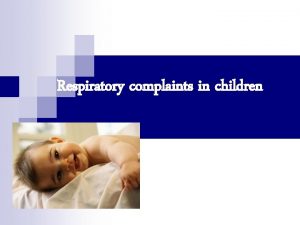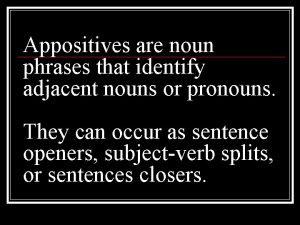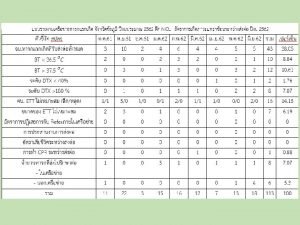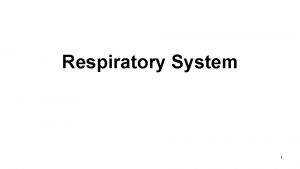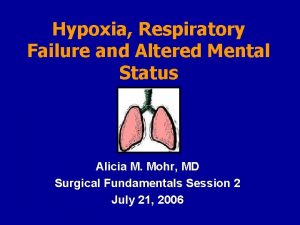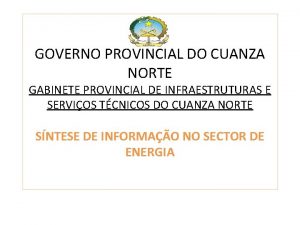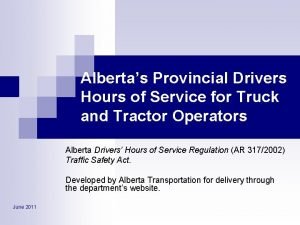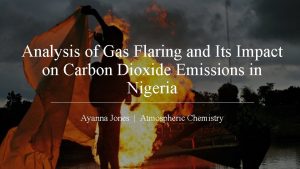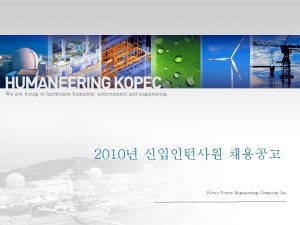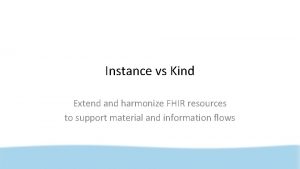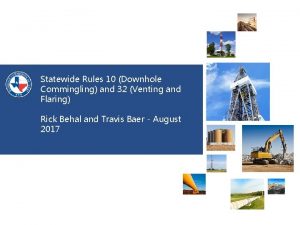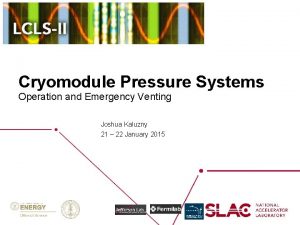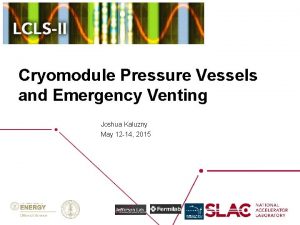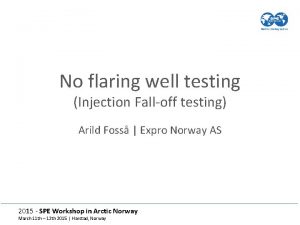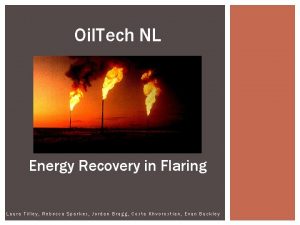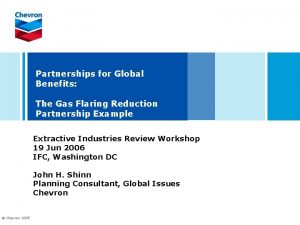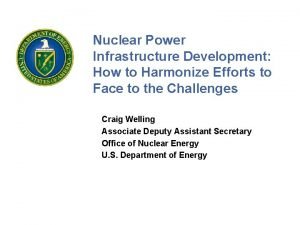FLARING AND VENTING CAN WE HARMONIZE PROVINCIAL DEFINITIONS


















- Slides: 18

FLARING AND VENTING CAN WE HARMONIZE PROVINCIAL DEFINITIONS? Industry Meeting April 17, 2012 Presented by Jim Spangelo and James Vaughan, ERCB and Kevin Parsonage M. A. Sc. , P. Eng. BC Oil & Gas Commission

ISSUE/RECOMMENDATION Harmonization of flare and vent definitions with other provincial regulators.

1 A. ADVANTAGES OF HARMONIZATION • Prevent errors occurring because of different rules between provinces • Cost savings to industry by not having to maintain and follow multiple definitions • If reporting is consistent and clear, reporting is more complete • Improved granularity will help improve conservation (numbers more visible) • Quality of flare and vent numbers for Canada will improve • Improved alignment with GHG reporting will help simplify industry reporting

1 B. IMPACTS OF HARMONIZATION • Cost to change production accounting systems • Cost to change reports and computer programs • Consultation effort with others prior to and after change • Greater granularity will result in extra cost for the measurement/estimating

2. Types of Facilities


3. Flaring - Definitions Examined - Current Reporting - Proposed Definition

Flaring Definitions Examined • Provinces • - AB D 56/D 60/D 17 - BC - AEW Specified Gas Emitters Regulation - Newfoundland Offshore - Sask - GNWT Federal/NEB Federal/Env Can US EPA GHG Reporting (40 CFR Part 98, Subpart W) • GGFR (Global Gas Flaring Reduction Initiative) • •

FLARING AND VENTING Current Reporting • Spreadsheet

4. NEW PROPOSED FLARING DEFINITION Flaring • Flaring includes gas streams directed to a flare or incinerator stack for combustion. (Acid gas directed to a sulphur plant incinerator and fuel gas directed to a sulphur plant incinerator are excluded. ) • • Flaring includes: - Flared fuel gas (fuel gas directed to flare to enhance dispersion and to improve combustion efficiency, purge gas, flare pilot gas), - Flared waste gas, and - Flared acid gas continuously or intermittently flared. Flared fuel gas, flared waste gas and flared acid gas should be separately reported.

WHY? • Easy to understand • Easier to verify based on field observations • Brings more attention to fuel gas to flare • Easier to measure a total flared number • More consistent with other jurisdictions

Other Whys for Alberta • Alberta specifies gas plant flare limits as percent of receipts – we don’t want to penalize plants for flaring fuel gas and acid gas which aren’t part of this limit now – we aren’t planning to change limits • ST 60 B numbers will go up, without explanation, if we can’t separately break out flared fuel gas and flared acid gas – we want to be able to separately report on these so we can clearly show the change in reporting

Flare Measurement Expectations • Total Flared Ø >0. 5 E 3 M 3/d (annual average per site) Metered (5%) Ø <=0. 5 E 3 M 3/d 20% Estimate Accuracy - Flared Waste Gas • Estimate with 20% accuracy - Flared Fuel Gas • Dilution gas must be metered (5%) • Other fuel to flare (eg purge and pilot gas) may be estimated 20% Accuracy - Flared Acid Gas (maybe 150 facilities) • Acid gas must be metered (5%) Note: For total fuel gas reporting you must subtract estimated purge and pilot gas.

5. PROPOSED NEW VENT DEFINITION Venting • Venting is the direct emission from the intentional releases to the atmosphere of hydrocarbon or CO 2 gas. • Venting includes: - vented fuel gas - vented waste gas, and - vented CO 2 where the stream is primarily CO 2 Each of these streams should be separately reported. • Reporting fugitives (unintentional leakage) as part of reportable venting is optional. • Where gas contains CO 2 because of the nature of operation – such as well fracturing operations or underground combustion these vented amounts should be split between CO 2 reported as CO 2 and hydrocarbon reported as waste gas.

WHY? • • • Simple and Easy to Understand. Anything vented is reported as vented. This makes it easy for regulators, industry and the public to understand. Thus venting will more likely get reported. Consistent with Alberta, BC, and Federal GHG reporting (for the most part) Brings attention to anything vented – even fuel gas Improvements made when moving away from hydrocarbon pneumatic devices are more visible. A number of companies are moving to either low bleed pneumatics or to air or solar power for running pumps and controllers. This reporting of vented fuel gas will allow companies to track their success. Improved GHG reporting – fuel is normally assumed to be combusted, this helps ensure that the 25 x GHG potential of methane vent gas is properly accounted for.

Vent Measurement Expectations - Vented Waste Gas • >0. 5 E 3 M 3/d (annual average for vent waste per site) Meter (5%) • <=0. 5 E 3 M 3/d estimate 20% Accuracy - Vented Fuel Gas • Fuel to vent may be estimated with 20% accuracy - Vented CO 2 (small number of facilities) • >0. 5 E 3 M 3/d (annual average per vented CO 2 per site) Meter (5%) • <=0. 5 E 3 M 3/d estimate 20% Accuracy What about Nitrogen?

6. PATH FORWARD - Expectations on Measurement/Estimating? - Accounting impacts/ Petroleum Registry impacts?

Questions/ Comments?
 Welcome to service
Welcome to service 42 lines harmonize
42 lines harmonize Chick means
Chick means Wet venting rules
Wet venting rules Thermally initiated venting system
Thermally initiated venting system Tachypnea causes
Tachypnea causes Coronal flaring
Coronal flaring Back technique
Back technique The sound of approaching grain teams
The sound of approaching grain teams Nasal flaring
Nasal flaring Internal and external respiration
Internal and external respiration Respiratory distress nasal flaring
Respiratory distress nasal flaring Society and culture in provincial america
Society and culture in provincial america Chapter 3 society and culture in provincial america
Chapter 3 society and culture in provincial america Limpopo development plan 2020
Limpopo development plan 2020 Provincial achievement tests
Provincial achievement tests Governo provincial do cuanza norte
Governo provincial do cuanza norte Provincial hours of service alberta
Provincial hours of service alberta Provincial salary rate
Provincial salary rate





